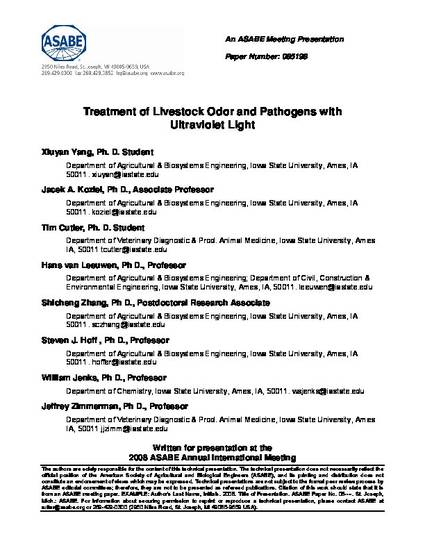
Livestock production systems are associated with aerial emissions of odor, volatile organic compounds (VOCs), other gases, and particular matter including airborne pathogens. Control of those emissions is needed to assure compliance with environmental regulations and long-term viability of the industry. The focus of this research is a novel approach to abatement of livestock odor and pathogens utilizing photocatalysis, i.e., UV irradiation in presence of TiO2 as a catalyst. A standard gas generation system was built and tested to generate ten odorous VOCs commonly defining livestock odors. These VOCs included methylmercaptan, ethylmercaptan, dimethylsulfide, butylmercaptan, acetic, propanoic, butyric, and isovaleric acid, p-cresol, and H2S. Our previous research established a reduction of VOCs with UV light only of 60~98% for sulfur VOCs and 91% for p-cresol, but only 20 to 45% removal for volatile fatty acids (VFAs). Titanium dioxide was used in the current research to catalyze UV reactions in the same gas mixtures of VOCs held in a small photoreactor. The reactor was designed to conduct controlled tests with UV light under dynamic (with airflows) conditions that facilitate experiments simulating exhaust from mechanically-ventilated barns. Six 10W lamps with characteristic bands at (185), 254, 312, 365 nm, respectively, and principle output at 254 nm were used as UV source in dynamic system. Solid phase microextraction (SPME) fibers were used to sample VOCs before and after UV treatment and for transfer of samples to a gas chromatography and mass spectrometry olfactometry (GC-MS-O) system. Odor analysis was completed by a forced-choice dynamic-dilution olfactometer in the Olfactometry lab at ISU. Effectiveness of four different treatment options, i.e., UV254, UV185+254, UV254+TiO2, and UV185+254+TiO2 was assessed. Effect of light energy, catalyst presence and light wavelength was evaluated. More than 50% in chemical reduction was found for all VOCs tested with a treatment time of 18.5 second. A linearly positive correlation was found between the percent conversion of tested VOCs and light energy dose. TiO2 showed to greatly improve the treatment effectiveness on VOCs, VFAs in particular, no matter deep UV was used or not. However, when TiO2 was used, deep UV showed very little improvement in degrading VOCs tested, while significant improvement was observed when no TiO2 was used. Total odor reduction of 70% by certain energy level indicated the feasibility of odor mitigation by UV light. Continued work includes simultaneous inactivation of airborne pathogens with UV light.
Available at: http://works.bepress.com/jacek_koziel/5/

This is an ASABE Meeting Presentation, Paper No. 085198.